Selection of High Strength Stainless Steels for Aerospace, Military and Other Critical Applications
Technical Guide
High strength stainless steels and age-hardenable superalloys are rapidly gaining favor with designers in the aerospace, military and other industries who are challenged to meet higher performance expectations and stringent regulatory requirements at lowest life cycle cost.
These specialty alloys are largely upgrades of conventional stainless steels and high strength alloy steels that are no longer able to meet the more demanding requirements of critical applications that keep growing in number and variety.
Resistance to corrosion is of paramount concern since the costs of corrosion, with its material degradation, continue to escalate more than most realize. According to a recent study conducted by CC Technologies Laboratories, Inc., for the Federal Highway Administration (FHWA), the direct cost of corrosion in the U.S. is $279 billion dollars a year, or 3.2% of the nation’s GDP. If one adds the indirect costs to the consumer the cost is doubled in terms of both dollars and GDP.
Conventional stainless steels can provide the corrosion resistance needed for many demanding applications, but increasingly they lack the combination of high strength, toughness, fabricability and damage tolerance. Standard high-strength low-alloy steels (HSLA) may offer the high strength needed for some difficult applications but lack the corrosion resistance.
Efforts to improve the corrosion resistance of high strength alloy steels with cadmium plating or other means of surface protection seem to be falling out of favor. This may be due to the growing, widespread objections to cadmium plating for environmental reasons, and the high costs of plating bath disposal. Furthermore, many recognize that surface treatment is not a viable, long-term solution to providing corrosion resistance nor achieving lowest possible life cycle costs.
The high stakes in materials can be appreciated better when examining the needs of two pertinent industries, aerospace and military. With its landing gear hardware, wing assemblies and other airframe components made of high strength stainless steels, the aerospace industry must achieve superb performance, long term safety, reliability, durability and low life-cycle costs – in short, aircraft that will fly for 30 years with minimal maintenance.
For its newer armed forces, the military seeks high performance alloys that will contribute to every major future platform with a focus on weight savings, improved corrosion resistance, higher strength while achieving lowest possible life cycle costs. The overriding objectives here are reliability and perpetual readiness (meaning no crippling rust from corrosion and ability to maintain peak mechanical performance).
High Strength Stainless Steels
An alloy is generally considered a high strength stainless steel when it meets several key requirements. First, it must have an ultimate tensile strength (UTS) of 225 ksi (1550 MPa) or more, and a minimum yield strength (YS) of 200 ksi (1378 MPa). Tensile ductility must be good, with a minimum 10% elongation preferred.
To further qualify as a high strength stainless, the alloy generally exhibits fracture toughness as least as good as that of 15-5 PH stainless (S15500). It also must have general corrosion resistance similar to that of Type 304 stainless, with good resistance to stress corrosion cracking (SCC).
Six Carpenter Technology martensitic, precipitation (age) hardened (PH) stainless steels meet all the defined requirements. They are 15-5 PH stainless, Custom 450® stainless (S45000), 13-8 (S13800), Custom 455® stainless (S45500), Custom 465® stainless (S46500) and the newest addition, Custom 475® stainless. Their nominal chemical compositions are shown in Figure 1.
Figure 1 – Nominal compositions of commonly used high strength stainless steels
|
15-5 PH stainless |
Custom 450 stainless |
13-8 stainless |
Custom 455® stainless |
Custom 465® stainless |
Custom 475™ stainless |
|
|
Cr |
15.0 |
14.8 |
12.7 |
11.5 |
12.0 |
11.0 |
15Cr-5Ni PH stainless offers high strength and hardness, excellent corrosion resistance with good forgeability and transverse toughness. A drop-in variation of this alloy (15Cr-5Ni Project 70+® stainless) meeting all 15Cr-5Ni specifications, offering improved machinability, has been used for the economical production of aircraft structural components.
Custom 450 stainless combines the very good corrosion resistance of 304 with the moderate strength of 410 and is relatively easy to fabricate.
13Cr-8Ni stainless combines high strength and hardness with good levels of resistance to both general corrosion and stress corrosion cracking. Generally, this alloy should be considered where high strength, toughness, corrosion resistance and resistance to SCC are required in a steel showing minimal directionality in properties.
Custom 455 stainless offers higher strength and hardness capability (about HRC 50) than Custom 450 stainless. It has good corrosion resistance coupled with ease of fabrication.
Custom 465 stainless is a premium melted, martensitic, age hardenable alloy capable of 250 ksi (1724 MPa) UTS when aged at 950ºF (H950 condition) – which is 20% higher strength than possible with traditional stainless steels and is currently covered by the MMPDS–01, AMS 5936 and ASTM A564 specifications. The alloy also possesses excellent notch tensile strength and fracture toughness in this condition. Overaging to the H1000 condition provides a superior combination of strength, toughness and SCC resistance compared with other high strength PH stainless steels such as Custom 455 stainless and 13-8 stainless.
Custom 475 stainless is Carpenter’s newest premium melted, high strength, martensitic, precipitation hardenable stainless steel. It provides good corrosion resistance and was designed to achieve up to 290 ksi (2,000 MPa) UTS combined with good toughness and ductility when peak aged at 975ºF (H975 condition). Other combinations of strength, toughness and ductility are possible by applying aging temperatures up to 1100ºF. The alloy is currently available in strip, wire and small diameter bar.
Major Considerations
For many critical applications, the proper balance between an alloy’s fracture toughness and specific strength is important. Figure 2, which includes Carpenter’s ultra-high strength AerMet® 100 and AerMet® 310 alloys, and a titanium grade, indicates that the combination of strength and toughness for Custom 465 stainless bridges the gap between the high strength steels and conventional stainless steels. Although not obvious from this chart, Custom 465 stainless exhibits 43% higher fracture toughness than Custom 455 stainless.
Figure 2 - Relative range of fracture toughness and specific strength for high strength alloy steels and PH stainless steels
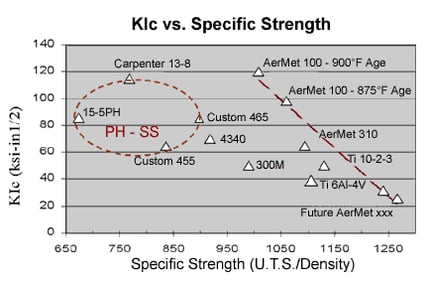
The military and aerospace, among other sectors, would like to capitalize on the light weight advantages of metals like aluminum and titanium, to the extent permitted by strength requirements. One high strength stainless, Custom 465 stainless in particular, addresses the need for light weight. It offers a strength-to-weight ratio approaching that of titanium. Furthermore, it offers a still higher ratio capability in rolled strip, wire and small diameter bar.
Custom 465 stainless excels in damage tolerance, an attribute coveted by the military and aerospace. This, in effect, is a measure of the alloy’s ability to absorb energy and continue functioning in the presence of a failure. Materials specifiers have been willing, in some cases, to trade off strength to get more damage tolerance and corrosion resistance.
Damage tolerance of various alloys is compared in Figure 3. The alloys are ranked based on the results of KIc (fracture toughness) and notch ductility tests. Custom 465 stainless in the H950 condition is rated second highest in damage tolerance, and Custom 455 stainless in the H950 condition is ranked sixth. AerMet® 100 alloy, which is not a stainless steel, was ranked first in the study.
Figure 3 – Ferrous-based and titanium alloys ranked by damage tolerance
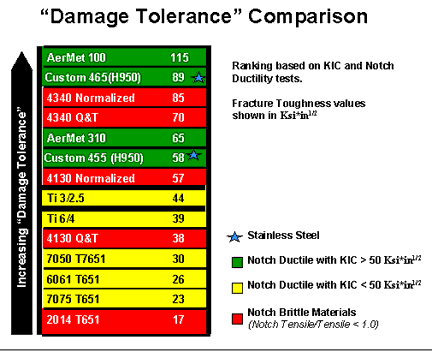
The PH stainless steels considered in this discussion all have superior combinations of tensile strength, fracture toughness, resistance to general corrosion and resistance to stress corrosion cracking (Figure 4). The 17Cr-4Ni PH stainless (S17400) is included in the bar chart because it is a good baseline alloy for comparison.
Figure 4 – Relative strength, toughness, corrosion resistance and SCC resistance of key high strength, age-hardenable alloys
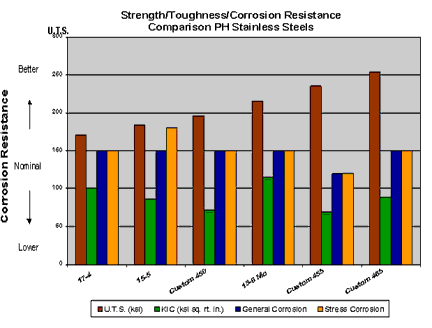
Custom 465 stainless, the newest alloy in the group, is shown in the chart to have greater strength than any of the PH stainless steels. In fact, it can achieve more than 20% greater strength than the other PH stainless alloys shown. In addition, Custom 465 stainless has corrosion resistance clearly better than that of Custom 455 stainless, and equal to all the other grades in the series.
Alloy Selection
Carpenter has developed a simplified selection technique for choosing stainless steels known as the Selectaloy® method. It is a simplified approach to choosing the most suitable alloy for an application based on two criteria, corrosion resistance and strength. A brief explanation of this selection method may help in understanding how it works.
The selection process begins after due consideration is given to life cycle costs rather than lowest initial cost – i.e. what’s more important, the initial cost of the alloy or the cost of production/process failure or poor performance if the alloy choice is wrong?
Then the materials specifier must determine how much corrosion resistance is needed, and how much strength is required for the specific application. Corrosion resistance increases from bottom to top of the vertical axis in the basic diagram (Figure 5), and strength increases from left to right along the horizontal axis.
Figure 5 – Selectaloy diagram showing relative corrosion resistance and strength of 14 stainless steels
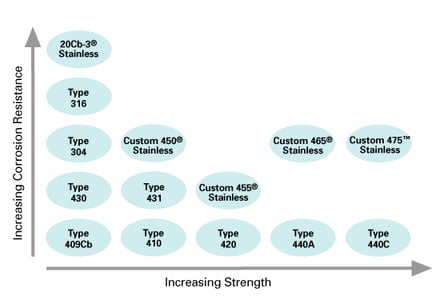
It is best to start with 304 stainless, the alloy specified more than 50% of the time when a stainless steel is needed. For greater corrosion resistance, move up sequentially to 316 or 20Cb-3® stainless. For less corrosion resistance, drop down to 430 or 409Cb.
If more strength is needed at the lowest level of corrosion resistance, move to the right of 409Cb. Start with 410, then go progressively to 420, for more strength to 440A and for greatest strength to 440C.
For more corrosion resistance, move up one level. If more strength is needed than that offered by 430, move right to 431 or Custom 455 stainless for greatest strength.
If still more corrosion resistance is needed, move up to the third level. For more strength than that of 304, move right to Custom 450 stainless. For still more strength, continue moving right to Custom 465 stainless and Custom 475 stainless.
The diagram now shows at a glance the relative corrosion resistance and strength of 13 commonly used stainless steels – including three of the high strength PH stainless steels highlighted in this article.
Based on the same concept of relative values, a new Selectaloy® method and diagram (Figure 6) has been developed that compares the specific strength (UTS/density) and fracture toughness of pertinent alloys commonly used where very high strength is required.
Figure 6 – Selectaloy diagram comparing high strength alloys according to their relative fracture toughness and specific strength
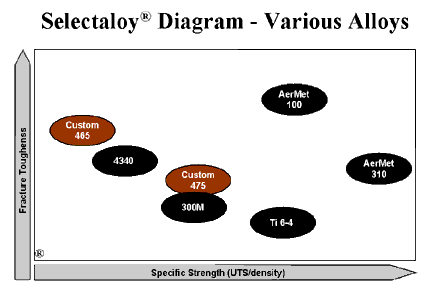
Custom 465 stainless and Custom 475 stainless join this small group of ultra-high strength steels. They bring not only high strength and corrosion resistance, but also fracture toughness better than that of all except AerMet® 100 alloy.
Positioning of the AerMet® 100 alloy indicates that it offers the best combination of strength and toughness. AerMet® 310 alloy provides the highest strength, with slightly less fracture toughness than its predecessor alloy. AerMet® 310 alloy offers the ultimate high strength-to-weight ratio of this family of alloys.
The well known 4340 and 300M ultra-high strength alloys have less strength than the two AerMet® alloys and distinctly less fracture toughness than AerMet® 100. The titanium grade, Ti 6-4, has an excellent strength-to-weight ratio, but lower fracture toughness than all the other steels shown. It is also a more expensive material.
Applications
Custom 465 was first specified in the aerospace industry for tension rods in the Joint Strike Fighter. It has since been approved for use in structural components such as flap tracks, slat tracks, actuators, engine mounts and landing gear hardware. With its certification and demonstrated performance, the stainless is being chosen by military and aerospace manufacturers for both new components and retrofit applications.
Custom 465 stainless can be considered as a corrosion resistant replacement for 300M (which contains a slightly higher UTS but lower toughness), AISI 4340 and other similar types of steels typically used in high strength aerospace applications. It can also be considered as a higher strength replacement for stainless steels such as 15Cr-5Ni, 17Cr-4Ni and 13-8 stainless steels.
It is the combination of high strength, toughness and corrosion resistance provided by Custom 465 stainless that convinced one aerospace company to use it for new torque tubes and flap tracks in lieu of other PH stainless steels and alloy steels. In one case, several structural parts for a new plane design required higher strength that that offered by the PH stainless steel that had been previously used in such applications. This same manufacturer has been evaluating the use of Custom 465 for flap tracks and flap carriages again because it matches the strength of the alloy steel currently used while also providing corrosion resistance.
In general, Custom 465 stainless is less sensitive to process parameters than other high-strength PH steels. It's relatively low annealed yield strength, along with a low cold-work hardening rate, have made stainless well suited for producing fasteners and drawing small diameter wire. Another aerospace manufacturer, in fact, is considering Custom 465 stainless for aerospace fasteners because it has higher strength than both traditional PH stainless steels and many superalloys currently used for structural applications. In addition, the Carpenter grade has proven to be thermally stable after long-term exposure to elevated temperatures.